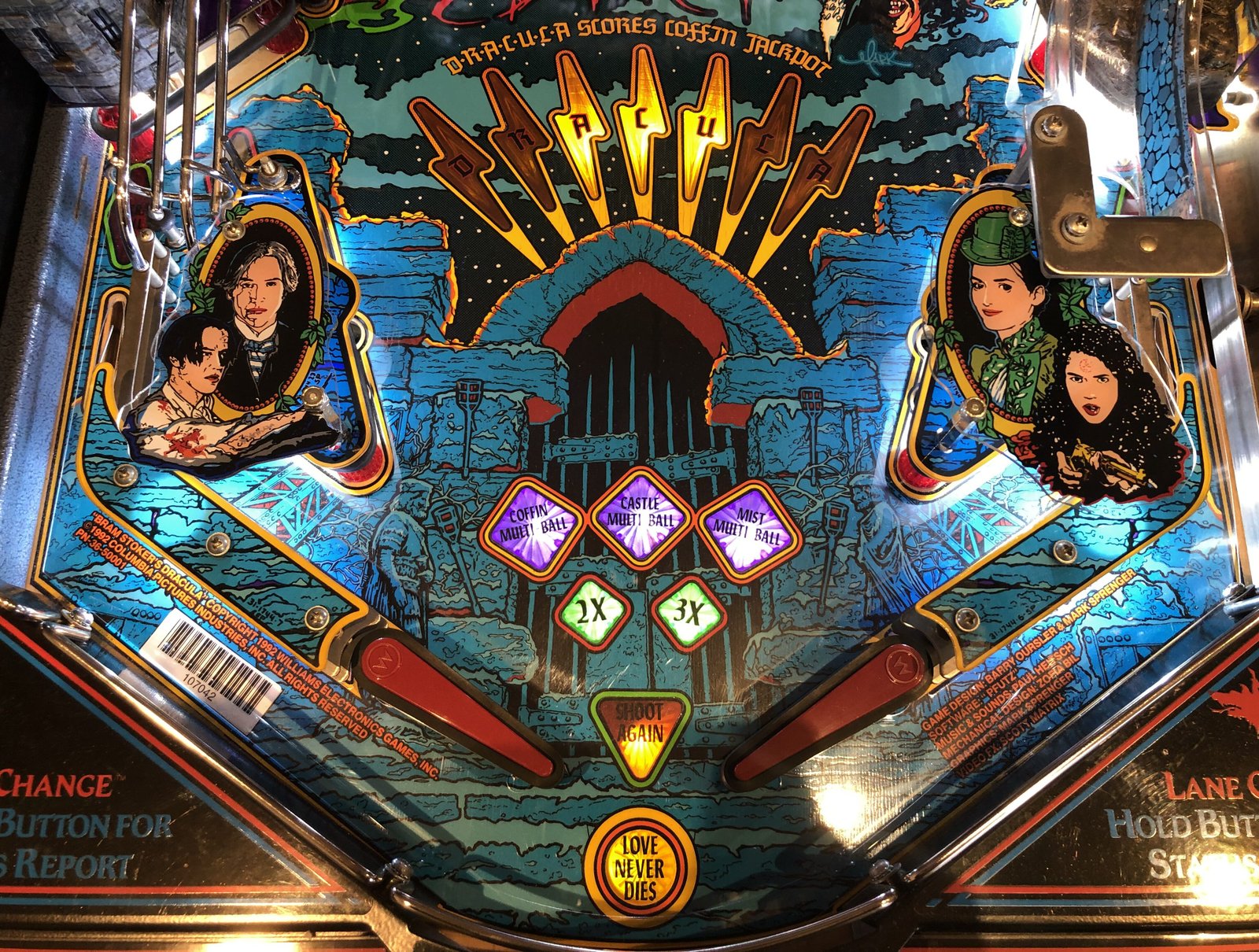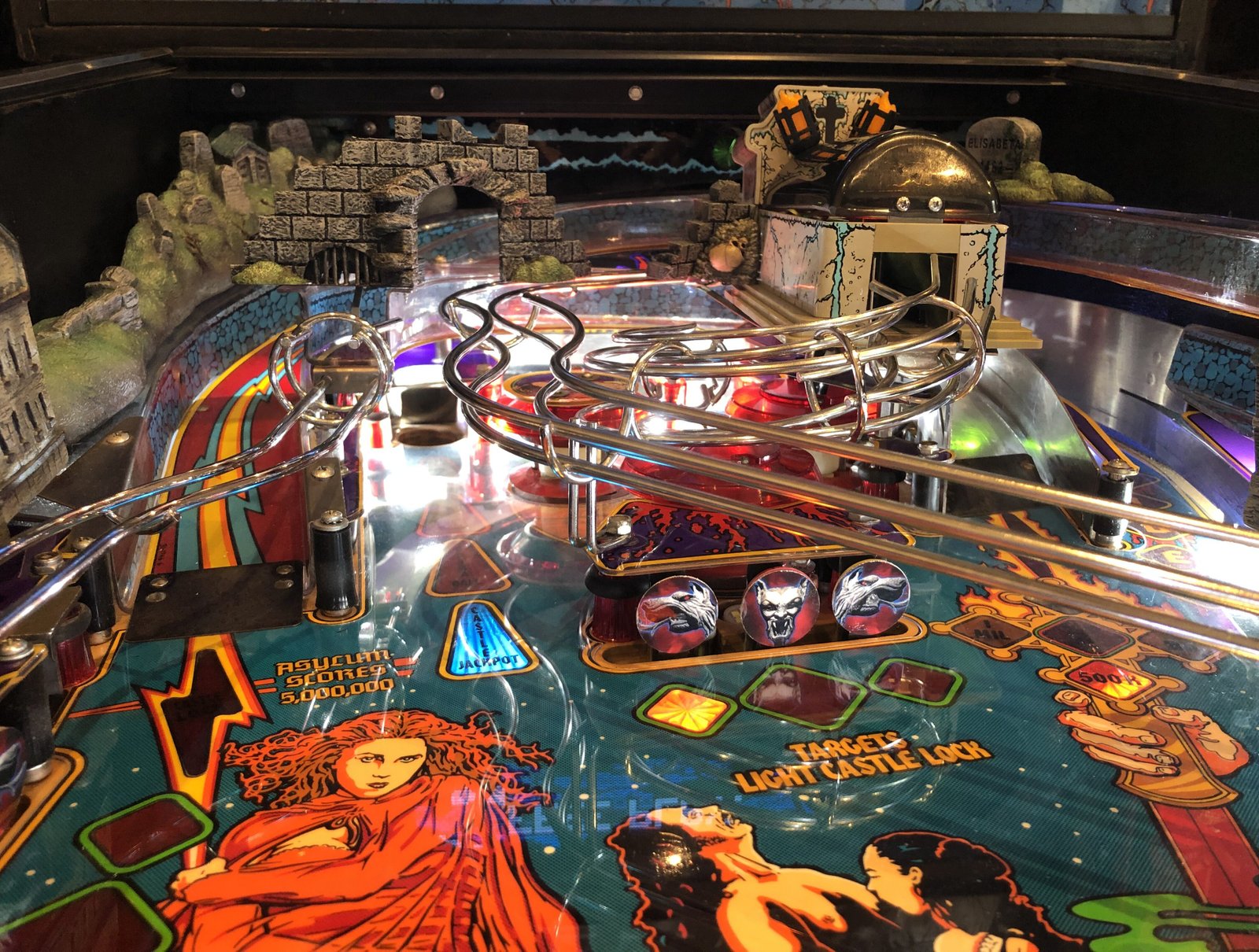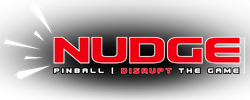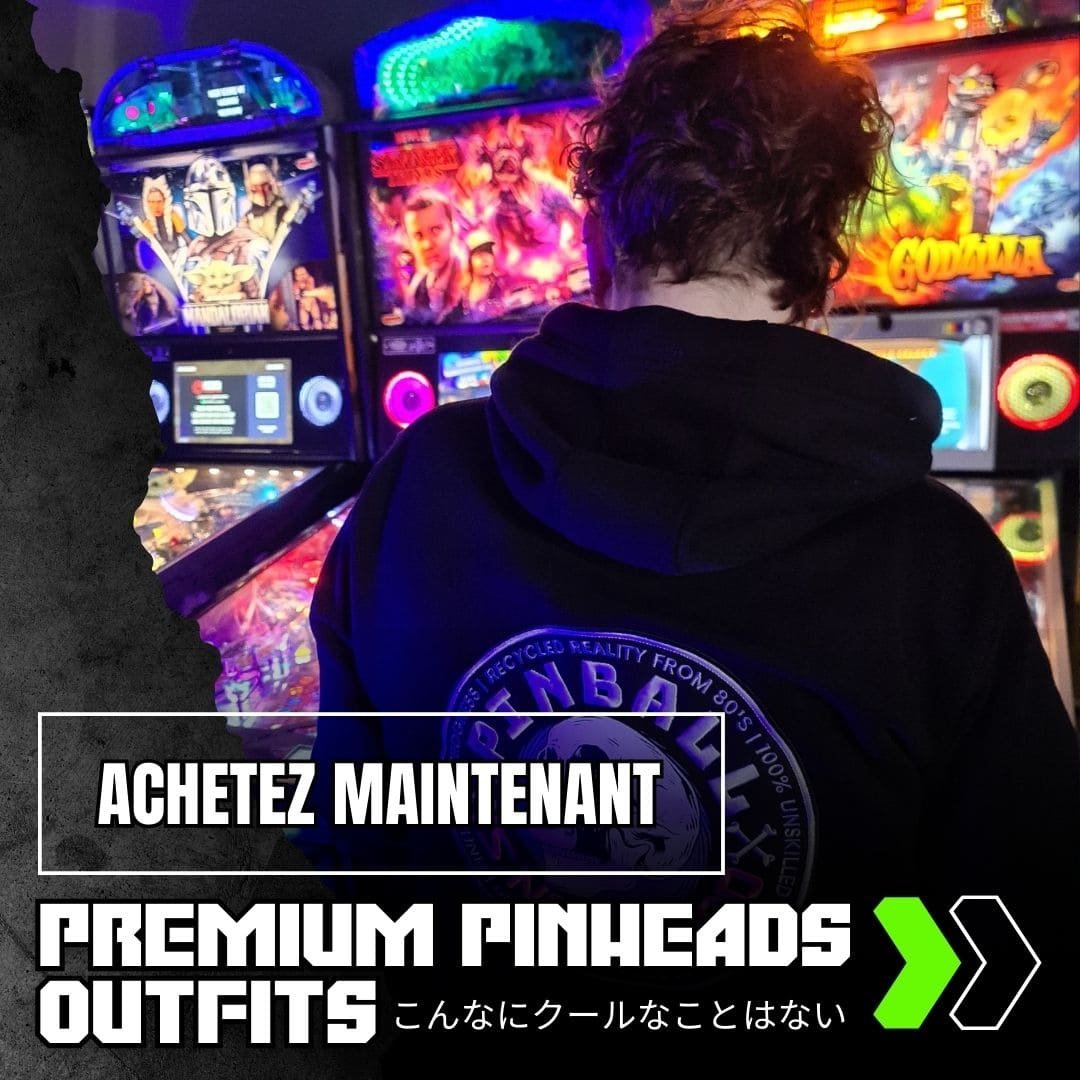If there is one constant in the Bally/Williams machines of the 90s, it is their omnipresent humor. This is one of the aspects that forged their reputation and made their charm. Whatever the theme, there is always the little dot animation that makes you smile, the fun game mode, the call-out that goes well or the lively music.
It must be said that in this “pinball” landscape, Bram Stoker’s Dracula (BSD) is the ugly duckling. Not only because of its theme, but also because of the way it is approached. Gameplay, sound ambiance, animation of the DMD screen, design… everything reminds of fear, death, blood and revenge of the lost love of good old Vlad Dracul.
Where pinball machines with rather serious themes, taken from movies or series, sometimes even horrific, have become quite common today (e.g. Walking Dead at Stern or several models in this spirit at Spooky Pinball), it was clearly less in vogue in the 90s.
So today, we’re tackling this Williams classic. Take your garlic cloves, your stake and put on a little wool, we’re off to the cold Carpathians to deconstruct this so… particular machine.
Sommaire
I never drink… wine.
Barry Oursler (Gorgar, Fire!, Cyclone, Dr Who…) is mainly responsible for the game design of this Bram Stoker’s Dracula, taken from the 1992 film of the same name directed by Francis Ford Coppola (the pinball machine will be released a few months later, in 1993).
He will have the heavy task of transcribing through a game, the atmosphere so heavy and distressing of this film which is similar for some to a real work of art.
But before talking about the gameplay, let’s take a look at the design of this machine, because like the movie, the visual aspect holds a very special place.
The box, first of all, enjoys a considerable effort in the artwork that covers it. We find the village of Transylvania overhung by the castle of the Count, in shades of blue in the middle of a dark night where only the Moon stands out with a strong yellow on the sides of the pediment. The whole is covered by the inscription “Bram Stoker’s Dracula” in a red… blood, of course. It’s beautiful, it’s detailed and it sets the tone!
The translite is a mix between some of the cult scenes of the film and some of the main actors (including Anthony Hopkins and Gary Oldman) in a photomontage way. The least we can say is that it’s neither pretty nor cleverly done. The layout of the elements is not really coherent if we refer to the film and the rendering is a patchwork. I’m not even talking about the Count of Dracula, who is represented in his ugliest possible version, in close-up on almost the entire translite.
At least, we stay true to the theme, you may say, but as for attracting the player in the middle of several machines, it is not won!
Fortunately, the playfield makes up for it rather well, since it offers a nice range of all the scenes of the film through a rich, complex and well arranged artwork. In addition and for lack of big toys, we find a lot of scenery that brings volume and “3D” giving a little more life under the ice, including :
- The castle of Count Dracula on the right, which serves as a ball lock
- The village of Transylvania on the left, which hides several eject holes
- The cemetery on the top left, which covers the main ramp
- And of course, the tomb of dear Dracula, accessible through a secret hole, hidden under a ramp (Note that a figurine representing Dracula is present and visible by transparency during some phases of the game)



Even if the original finish of these elements leaves a little to be desired (the versions presented in this article have been entirely repainted by my friend from Z Axis Studio), one can only underline the effort of Williams to equip its machine with full decors and not simple printed plexis.
NB: Originally, the BSD contains two levels of slingshots sets: the bricks of the castle in the extension of the playfield first, then slingshot covers representing two actors of the movie (Keanu Reeves and Winona Ryder) fixed on them thanks to spacers.
Except that no model was provided with these famous slingshot covers during the production (contrary to what we can see on the promotional flyer).
Barry Oursler will explain years later, without naming him, that one of the two actors didn’t finally give his consent for the use of his image.
But Williams had already produced its entire stock of spare plastics, including these two parts. They were therefore available for sale just after the release of the machine and it was very easy to get them.
Original NOS (New Old Stock) parts or faithful reproductions, this is a must if you want to find this machine with its “real” design.

Why make it complicated when you can make it simple?
The generation of dots often marks the arrival of mission pinball machines, meaning machines that have a beginning and an end (a wizard mode) where a sequence of different actions must be done in a specific order to get there.
Well, with the Dracula, forget it! Williams has decided to make a scoring pinball machine with several actions to perform in the order you want, while playing with multipliers and bonuses.
In addition, this machine allows you to stack your multiballs. You can throw a multiball and then another one at the same time, which increases your number of balls on the board and mixes your objectives. Needless to say, this kind of strategy raises the bonus multiplier and ensures big endgame scores.
Despite the simplicity in this approach, the gameplay remains rich and there is no risk of getting bored given the number of things to do. In bulk we find :
- Bats to scare away, based on the same principle of targets/switches
- The Castle Multiball which is obtained by locking your balls via the dedicated ramp
- The wolves to kill in a video mode (like a first person shooter, you have to shoot them with the pinball buttons. All this while saving your bullets and waiting for the last moment to aim at them to make higher scores)
- The Mist Multiball and its famous ghost ball that crosses the board to the sound of Dracula’s “Winds, winds, wiiiiiiinds!”
- The different ramps (with diverter) that launch specific actions
- The Coffin Multiball, where you have to shoot Dracula with 3 stakes in the heart by sending the balls into his coffin
- The asylum where Renfield is locked up, accessible almost only by chance as the ball trajectory to get there is so twisted!
- A very particular skill shot, for which different scores appear on the screen. You have to send the ball in a falling target hidden at the bottom of the board at the right time to validate the corresponding score

All this with a speed of play and a flow that does not leave you any respite!
In short, you will have understood, this gameplay is not complex but the pinball has a multitude of good ideas, subtleties of gameplay and innovative mechanics.
Believe in magic, Muggle!
Moreover, among these mechanics, we find again Zofia Bil (designer of the 3-level mini playfield of Dr Who) at the helm of the creation of a feature still as impressive 30 years later: The ghost ball.
Thrown through the Mist Multiball, a captive ball lodged under Dracula’s castle has the luxury of crossing the whole playfield in front of your eyes, following a green halo representing the demonic fog, waiting to be hit by a second ball to be released and offer you a 2 ball multiball.
Well, we won’t lie, this “magic” is somewhat spoiled by the “crrrrr… crrrr…” of the motor of the magnet that crosses the board keeping this ball in pseudo levitation, as well as by the very design of this feature, frankly capricious, especially after years of use.
Zofia has indeed played with a principle of optos (optical cells that react to light), long range to allow for this trick and unfortunately, the sequencing of all these optos at the same time now requires a little trickery to make this mechanism reliable and avoid the balls that fall constantly, a haunt of all owners of this model.
It was nevertheless daring for its time and no other pinball machine could boast such a technical feat. So reliable or not, we can only salute this risk-taking which made this feature cult for anyone who has ever laid his hands on this machine.

A “world under playfield”
As you know, at Pinball Mag. we often talk about the “World Under Glass”. In other words, all the richness that makes up a pinball table and the beauty of putting all its elements in motion. It is ultimately what gives life to our machines.

Well, on the BSD, we can really talk about “world under playfield” as this model is provided with elements above but also below the board.
The reason? The number of holes on the board that are connected by tunnels under the board (cellar holes) and that, in game, accentuate the eerie and mysterious side of this machine: A ball enters through a hole at the top of the board and comes out at the bottom under a decoration, or enters through a hole hidden behind a falling target, to come out through another hole hidden on the opposite side of the board… On the first games we see the balls disappear without ever knowing where they are going to come out again, nor at what speed!
This particularity, which gives this machine its charm when you play it, turns into a real hell as soon as you have to perform the slightest maintenance operation under the playfield.
Come drink my blood
As you can see, both the design and the gameplay fit the theme quite well. As for the general atmosphere, it is not left out for all that.
First of all, the screen animations are deliciously gory (believe me, this is clearly not something we’ve seen often in Bally/Williams) and pay perfect homage to the film. Whether it’s the stakes being driven into Dracula’s heart, the vampire sinking his teeth into Mina’s neck, the wolves being slaughtered coldly in a spray of blood, Dracula’s vampire wives turning into horrible creatures, the blood flowing over some of the animations… It’s varied and well-executed enough that it’s as enjoyable as it is unsavory to watch, and that’s ultimately all you want from a pinball machine like this.
NB: You will notice a small original feature on this machine: The glass of the speaker panel is tinted in red, which replaces the classic Black/Orange Dot Matrix Display by a Black/Blood Red to stick a little more to the theme (You will have to change the whole part if you want to change the original screen by a color screen)

As for the sound, this is perhaps where the atmosphere is a bit lacking. Not that the music is not good, on the contrary, but it is simply the technical constraints of the sound chipset of the time that make this famous nasal sound not always very pleasant to the ear, especially in the long run.
Again, you have to put this in the context of the time and when it came out, it was obviously quite honorable.
Let’s say that today, to give it a second youth (and believe me, it deserves it), we will not miss a Pinsound sound card and a mix with the music of the Coppola film.
As for the call-outs, they are taken from the movie and for the most part, from Dracula himself, so it would be difficult to do better. On this side, nothing to say, it is perfect.
Bloody replayability
If you put all these elements together, you get a tasty mix as unexpected as qualitative! Of course, this machine is not the one that will catch your attention first among other models that may be visually more attractive, but I can only advise you to take a look at it if you have the opportunity.
It has a real atmosphere at the same time heavy, sad and romantic in the pure line of the film, the whole sublimated through a terribly addictive gameplay.
And that’s the strength of this machine: its incredible replay value (editor’s note: ability to come back and play the same game without getting bored) compared to its simplicity. And this is perhaps what has made it so successful. It’s easy to understand, it’s fun, it’s fast and we go back to it with great pleasure.
Technical sheet
GENERAL :
Manufacturer: Williams (Midway Manufacturing Company)
Date of production : Avril 1993
Theme : Fiction / Licence de film
Type : Solid State / Standard Body
MPU : Williams WPC (Fliptronics 2)
Short name: BSD
Units produced: 6 801

TOYS / PARTICULARITIES :
The Mist Ball: a “ghost” ball that crosses the board in its width thanks to a system of magnets and long range optos.
The Coffin: reproduction of Dracula’s coffin in which the balls pass through to fall in the middle of the pop bumpers during certain phases of the game (accessible via a hole hidden under a ramp).
Notable features
Drop target (1)
Ramps (2)
Diverter (1)
Cellar holes (3)
Multiball (4 balls)
TECHNICAL AND ARTISTIC TEAM :
Game Design : Barry Oursler, Mark Sprenger
Mechs : Zofia Bil
Software : Bill Pfutzenreuter
Artwork : Mark Sprenger
Sound : Paul Heitsch
Music : Paul Heitsch
Dots/Animation : Scott Slomiany


